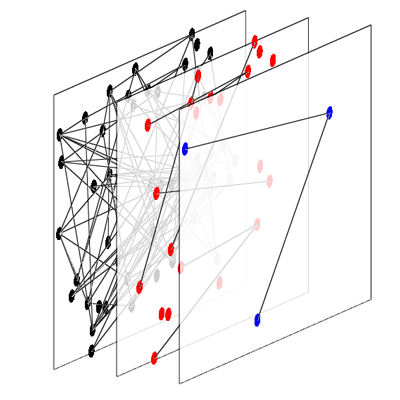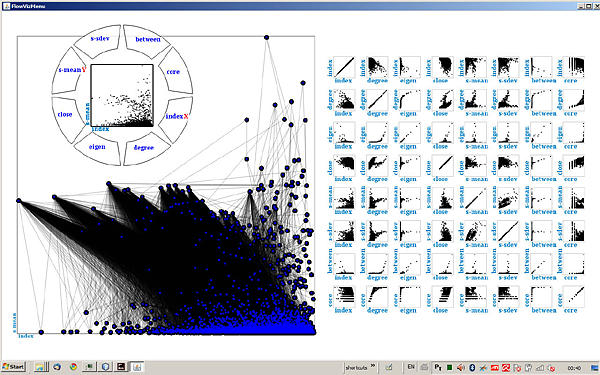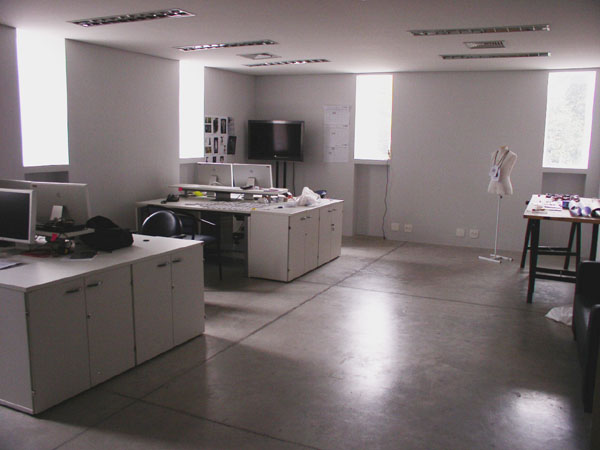Genoma Labs
I'm preparing an extension of this project: the Genoma Labs.
Participating art centers will become part of a virtual research consortium logging, analyzing and visualizing the evolution of the artificial phenomena that will be presented here at the MIS next year. Like watching for seisms, solar eruption, aurora borealis or ice cap meltdown.
The original project proposes a web access to visualize and to parasitize the evolution of the shape displayed in the exhibition. This extension of the project is now called Genoma Labs. The simplest implementation can be the integration in the website of the participating art center of an interface to visualize in real time the evolution of the shape (variation of the topology, activity level, genome configuration, parasiting level).
This is a first draft of part of the interface, for which I developed a 3D rendering engine in javascript/canvas based on a Devirtuoso code. If you don't see the animated 3D geometry, you can see it in a VIDEO.
Final visual
The final visual of the Genoma project is here.
It now reacts to ambient sound with moving light rays. The Supershape yellow lights evolves according to the Superformula equation, displayed on the bottom of the screen, and influenced by the Genome, the blue lights moving on the outer sphere and exchanging data.
The interface on the right side shows a mesh of the inner Supershape topology, a map of the Genome flocking and an analysis of the ambient sound of the gallery that parasitizes different zones of the Genome interaction. The structure reacts to the sound by moving rays of light, a bit like the hairs of the inner ear that reacts to different frequencies.
Graphstacker
The bioinformatics paper is building up rapidly, with a 30 pages litterature overview and already 1998 lines of code, including my joglFramework and 1144 lines written from scratch. The Klingons among you can take a look at the API.

Groundwork
Now that the visual part is mostly done, I'm working on some technical and conceptual parts, the real-time web framework and my next bioinformatics paper that will help me bridge the gap between the genome and the supershape.
Phenomena
The most important part of the visual looks like an unicellular organism or an astronomical phenomenon.
This is the final visual of the shape that will react to the voice of the user and evolve based on genomic data. It combines the second rendering of the superformula (in yellow-orange) and the flocking (in blue) occurs on the surface of a sphere. You can see this video IN HD directly on Vimeo.
The shape is composed of two parts: the genome in blue and the topology in yellow. The yellow topology evolves based on an equation called "Superformula" developed by the biomathematician Gielis. Starting from this principle, it can evolve in a variety of shapes. It's the genome role to steer this evolution.
Each blue point represents one protein that moves at the surface of a sphere an exchanges information with other proteins it encounters. The collective motion of these proteins are guided by a simple individual behaviour called "flocking", invented by Reynolds, that simulates complex formation of bird flocks and fish schools. This flocking is influenced, parasitized, by the voice of the user. The participant is thus a parasite in this evolutionary simulation.
Spherical harmonics
Spherical harmonics animated starting and ending as a sphere.
Another rendering of the superformula.
Fluid Flocking
A strange fluid simulation based on a flocking code that went mad.
This flocking behaviour, modified from the Mercato exhibition, will guide the interactions between the proteins constituting the genome of the shape. They will exchange part of their genetic code when they will meet.
Framework
I'm writing an OpenGl multitouch Java framework inspired by Processing. The geeks can get it at its
Google projects home.
Bioinformatics
I'm preparing an InfoVis conference about Hybrid visualization for bioinformatics network exploration.

My work at LabMIS will benefits from this project for the part where the shape feeds on bioinformatic data. You can see a VIDEO of it and read the INFOVIS PAPER.
Mutating Eclipse
I want this Supershape to slowly evolve, like a frozen mutating eclipse.
The idea is to prepare a shape to react to the voice of the user. A sphere can take complex shapes based on a real-time voice analysis, following an idea developed in a production residency at La Chambre Blanche.
LabMIS
I now work in the Post-production lab of the Museu da Imagem e do Som.

Genoma.Mercato
A first step of the project was presented in Italy before the residency.
A tactile interface is used to set the begining and ending variables of a 3D geometric animation that flock in an aquarium of other superformula creatures projected on the wall. This project was presented in Ex Lavatoio Hall, Mercato Saraceno, Italy and was organised by Anton Roca from The Rad’Art Project – Association Artéco, with La Chambre Blanche, the Association Aidoru and the municipality of Mercato Saraceno.
About
This website documents my generative art project at Museu da Imagem e du Som (LabMIS) in Sao Paulo. Here I describe the proposed idea that will change, mutate and evolve during the two months of this art residency.
Past production
I'm interested in the geometric structure of nature, in simple principles that give rise to a great diversity of living forms. I like those well known algorithms to simulate and generate organic structures (L-systems, cellular automata, Superformula). For this project, I wanted to combine this geometric recreation with my graphical work as a doctorate student in information visualization.
My research interest is in bioinformatic network exploration. So the project I presented to the MIS was to generate shapes feeding on genomic data. A virtual aquarium, where organic shapes interact with each others, represents the "genic pool" of a large 3D shape based on the Gielis Superformula equation.
Evolution of the project
The project is constantly evolving. Programming art is a bit like abstract painting. You don't know what will be the end result before you experiment, follow some insights and live with your code. And you often have to build your own tools, learn math and taking the best out of weird bugs.
I want the result to be coherent and subtle, but deeply complex and organic. My ultimate goal, if I only could, would be to create something as beautyfully frightening as a solar eruption, an eclipse, a nebula, an alien life form, constantly evolving guided by unknown laws of physics. In the meantime, I will continue to appreciate elegant equations that catch a glimpse of the simplicity of natural principles and of the complexity of life.
Thanks
This project is a collaboration between the Museu da Imagem e do Som in Sao Paulo and La Chambre Blanche, Avatar and La Bande Vidéo in Quebec. Part of the project is also developed for my doctorate studies at École de technologie supérieure in Montreal, funded by an SAP ARC project and a MITACS.



